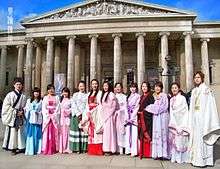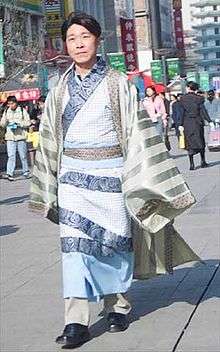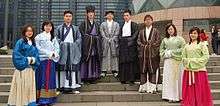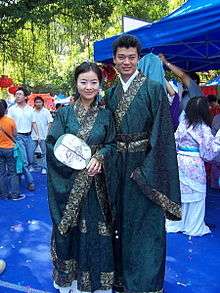Hanfu movement

Hanfu movement (simplified Chinese: 汉服运动; traditional Chinese: 漢服運動), or the Hanfu subculture, is a 21st-century movement that developed in China; its advocates want to reintroduce the wearing of hanfu for all Chinese in daily life as a way to stress values and support unity. This term encompasses the historical clothing styles worn by the Han Chinese before the Qing dynasty (1644–1912). While the Han Chinese comprise the largest ethnic group in China, there are 55 other ethnicities with their own traditions.
History

According to Asia Times Online, the Hanfu movement may have begun around 2003. Wang Letian from Zhengzhou, China, publicly wore Hanfu.[1] Wang and his followers inspired others to reflect on the cultural identity of Han Chinese. They organized the Hanfu movement as an initiative in a broader effort to revive and preserve the Han Chinese identity.
The Hanfu movement has been controversial since its initiation. While supporters often applaud its reviving of Han culture, some others criticize its exclusiveness. The Han Chinese society as a whole has not accepted revival of wearing Hanfu for daily wear. People who wear Hanfu in public, rather than what is now the more common western dress, are often considered eccentric.
Hanfu enthusiasts often hold events to encourage the public to wear this traditional clothing. Major events in recently years include Guan Li's and Ji Li's (Chinese coming of age ceremonies). Activists in this movement also wear Hanfu in numerous public and private ceremonies.
Definition of "Hanfu"
"Hanfu" is a non-academic, non-official noun associated with the historical dress of the Han Chinese people before the Qing dynasty.[2][3] Throughout China's long history, the clothing of the Han people has undergone many changes. Each dynasty had different styles, reflecting the varying interests of each period. The traditional clothing expressed its close relation to the traditional ritual teaching.
Its chief characteristics were symbolic of cultural moral and ethical values: the left collar covering the right represents the perfection of human culture on human nature and the overcoming of bodily forces by the spiritual power of ethical ritual teaching; the expansive cutting and board sleeve represents a moral, concordant relation between nature and human creative power; the use of the girdle to fasten the garment over the body represents the constraints of Han culture to limit human's desire that would incur amoral deed. In the Qing Dynasty, officials replaced the Hanfu with the costume of Manchu. Though many persons believe that the Qipao or Cheongsam is China's national costume, it is fairly modern. China has thousands of years of history. [4]
During the Qing dynasty, rulers required Manchu clothing only for Eight Banners members and Han men serving as government officials. Ordinary Han civilians were allowed to wear Han clothing, but most Han civilian men voluntarily adopted Manchu clothing, as it represented what the elite were wearing.[5] like Changshan on their own free will. Throughout the Qing dynasty, most Han women continued to wear Han clothing and did not adopt Manchu women's clothing.
Debates


In the 21st century, Hanfu advocates argue that making Hanfu a national dress could unite the country, creating a cultural symbol for China, and a renewed tradition for future generations.[6] But the movement's critics believe that this revival leans toward a narrow nationalism, and that it is focused on looks rather than content.[6] They fear that an effort to reject non-Hanfu dress could lead to a rejection of the West in terms beyond clothing style.
Other critics note that Hanfu is the traditional dress only of the Han people. The other 55 ethnicities of China might not want to adopt it and give up their own traditions.[6]
Recent developments
In February 2007, advocates of Hanfu submitted a proposal to the Chinese Olympic Committee to have it be the official clothing of the Chinese team in the 2008 Summer Olympics.[7] The Chinese Olympic Committee rejected the proposal in April 2007.[8]
| Wikimedia Commons has media related to Hanfu movement. |
Notes
- ↑ "Han follow suit in cultural renaissance", Asian Times Online
- ↑ 韩星 (2013-09-24). "当代汉服复兴运动的文化反思" (in Chinese). 中慧网. Retrieved 2014-01-18.
- ↑ 张跣《汉服运动:互联网时代的种族性民族主义》,中国青年政治学院学报(2009年第4期)
- ↑ "Chinese Clothing - Five Thousand Years' History". Culture Essentials Explore Chinese Culture. Retrieved 12/07/2011. Check date values in:
|access-date=(help) - ↑ Edward J. M. Rhoads (2000). Manchus and Han: Ethnic Relations and Political Power in Late Qing and Early Republican China, 1861–1928. University of Washington Press. pp. 61–. ISBN 978-0-295-98040-9.
- 1 2 3 "Should China Adopt Hanfu as Its National Costume? ", Beijing Review, 10 July 2007
- ↑ "Submission for a Proposal on Hanfu dress for the 2008 Chinese Olympics to the China Olympics Committee", Phoenix TV (Chinese)
- ↑ 官方首次表态北京奥运礼服不用汉服 (Chinese)